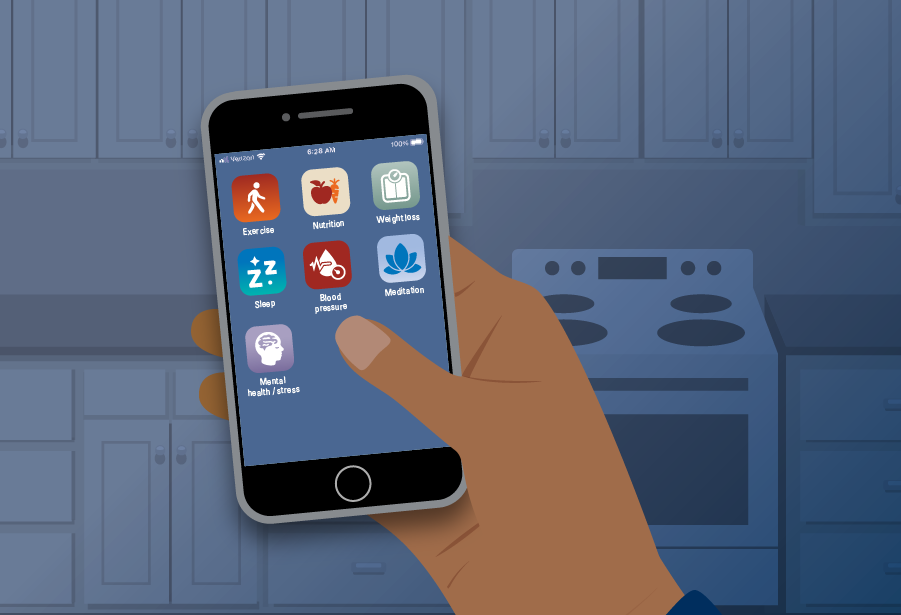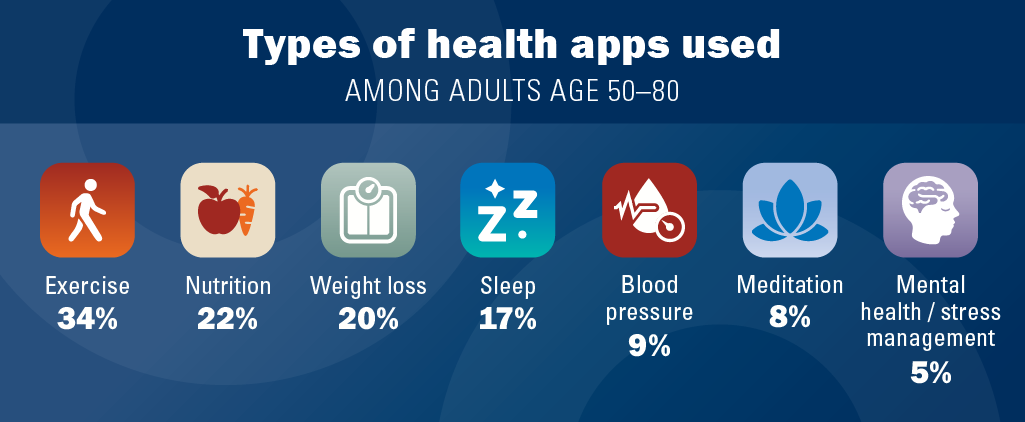
Mobile health apps allow users to learn more about their health, monitor health behaviors, and receive personalized support through a smartphone or tablet. More than 350,000 mobile health apps are currently available. Many of these apps focus on managing chronic conditions such as type 2 diabetes, and many also connect to other monitoring technologies such as continuous glucose monitors (CGMs). In August 2021, the University of Michigan National Poll on Healthy Aging asked a national sample of adults age 50–80 about their use of and interest in mobile health apps, including those for type 2 diabetes.
Use of mobile health apps
Nearly three in ten adults age 50–80 (28%) said they currently use at least one mobile health app, 16% reported that they used them in the past but not currently, and 56% have never used a health app. Adults age 50–64 were more likely than those 65–80 to have ever used a health app (49% vs 38%). Overall, 34% of older adults said they use or have used apps for exercise, 22% for nutrition, 20% for weight loss, and 17% for sleep. Older adults less commonly used apps for recording blood pressure (9%), meditating (8%), and/or mental health/stress management (5%).
Among those who have ever used a health app, one in four have used these apps to share health information with their health care providers. Seven in ten (70%) reported using them to keep track of their health, 39% to get information about health, and 9% to share or compete with family/friends.

Nearly one in four current and past app users (23%) were very confident that their personal data on health apps would be kept private and secure, while 58% were somewhat confident, and 20% were not confident about the security of their personal data on health apps.
Older adults who reported excellent, very good, or good health were more likely to use health apps than those in fair or poor health (29% vs 21%). Those with an annual household income of $100,000 or more were more likely to use health apps than those with a household income of less than $30,000 (43% vs 15%), as were those with at least a bachelor’s degree compared to those with a high school degree or less (40% vs 17%).
Among those who do not currently use health apps, about half (51%) said it was because of a lack of interest. Others said they never thought about using health apps (32%), were unsure whether health apps could help them (20%), or that they were uncomfortable with technology (14%).
Type 2 diabetes and health app use
About one in six older adults (17%) reported having type 2 diabetes. Of these, 39% said they have ever used a mobile health app. Among health app users with type 2 diabetes, 28% reported using a health app to track their blood sugar, while another 45% expressed interest in using an app for this purpose. In addition, 14% said they track their diabetes medication use with an app, and another 45% had interest in doing so.
Some health apps for type 2 diabetes work together with a CGM, a small patch worn on the skin to continuously measure blood sugar. Among respondents with type 2 diabetes, 11% currently use a CGM, 68% have heard of CGMs but have never used one, and 18% have never heard of CGMs.
Among those with diabetes who were not using a CGM, 56% said they were interested in using one.
Implications
Nearly three in ten adults age 50–80 currently use one or more mobile health apps, most commonly to track their physical activity, nutrition, weight loss, or sleep. About one in four health app users have shared information from their app with a health care provider. Sharing data from health apps is a potential opportunity for health care providers to help patients set and attain health goals.
While health apps have been promoted to help manage many chronic medical conditions, this poll indicates that a minority of older adults with type 2 diabetes are using a health app to help manage their diabetes, and even fewer are using a CGM. It is possible that more people could benefit from using a CGM, and the poll found that more than half of older adults who were not using a CGM would be interested in trying one. Clinicians should discuss CGMs with their patients with diabetes to determine whether these tools could be helpful to them.
While some people may not be interested in mobile technology or may find it challenging to use, for many older adults health apps offer an opportunity to support positive behaviors and may contribute to improved health outcomes.
Data Source and Methods
This National Poll on Healthy Aging report presents findings from a nationally representative household survey conducted exclusively by NORC at the University of Chicago for the University of Michigan’s Institute for Healthcare Policy and Innovation. National Poll on Healthy Aging surveys are conducted using NORC’s AmeriSpeak probability-based panel. This survey module was administered online and via phone in August 2021 to a randomly selected, stratified group of U.S. adults age 50–80 (n=2,110). The sample was subsequently weighted to reflect population figures from the U.S. Census Bureau. The completion rate was 64% among panel members contacted to participate. The margin of error is ±2 to 3 percentage points for questions asked of the full sample and higher among subgroups.
Findings from the National Poll on Healthy Aging do not represent the opinions of the University of Michigan. The University of Michigan reserves all rights over this material.
Read other National Poll on Healthy Aging reports and about the poll's Michigan findings, and learn about the poll methodology.
Citation
Lee P, Aikens J, Richardson C, Singer D, Kullgren J, Kirch M, Solway E, Smith E, Malani P. Mobile Health App Use Among Older Adults. University of Michigan National Poll on Healthy Aging. February 2022. Available at: https://dx.doi.org/10.7302/4019